A Walk Through Busch Reveals a Melding of Medicine, Science and Abstract Art
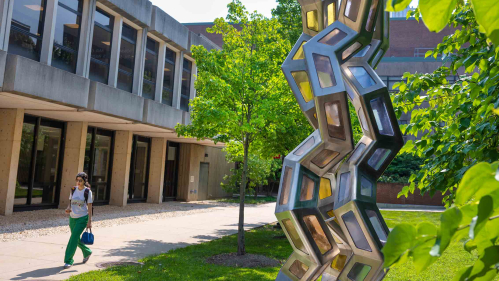
Works by renowned artists can be found throughout the Rutgers-New Brunswick campus in Piscataway, N.J., home of the schools of engineering and pharmacy
Busch campus of Rutgers University-New Brunswick is a blending of medicine and various sciences, including physics, pharmacy, engineering, psychology, mathematics and statistics, chemistry, geology and biology.
This Piscataway, N.J., campus – a hub of research and innovation as well as home to the School of Engineering and the Ernest Mario School of Pharmacy – also is a place showcasing art (much like College Avenue). Sculptures, many of them abstract and including works by former Rutgers professors, dot the campus grounds. Their backgrounds are as varied, too: Installed as early as 1973 and as recently as 2017, some of these works were publicly funded while others were gifted or privately funded.
Here is a nearly 2-mile walking tour (less than an hour) of many artworks throughout Busch campus, starting at the grassy space between the Busch Faculty Dining Hall and the Busch Engineering, Science and Technology Hall at the intersection of Bartholomew and Bevier roads:

Chichen Itza Blue
This 1986 geometric work was created by Igael Tumarkin, a German-born Israeli sculptor and painter known for incorporating symbols of Holocaust remembrance in his work. Bright and blue, the metal sculpture resembles a handcart and a short track of rails, which as noted on Rutgers-New Brunswick’s visits and tours web page, may allude to “the cattle cars used to transport prisoners to concentration camps.”
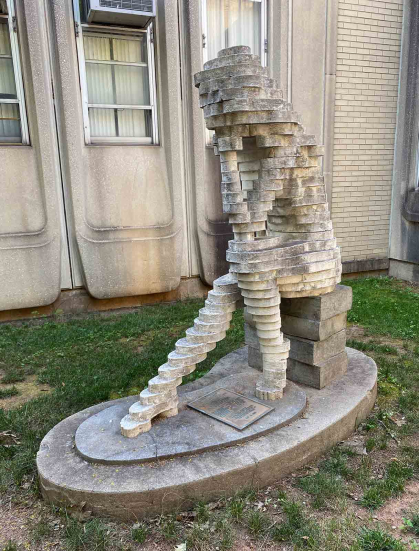
Reflections
Head east over to the School of Engineering’s labyrinth of quad buildings (specifically the D Wing section) on Busch and you’ll come across this contemplative figure seated on a stack of books – an abstract take on Auguste Rodin’s The Thinker. The sculpture was created by Reuben Karol, a former professor of civil engineering at Rutgers, as a gift from the Engineering Class of 1982.
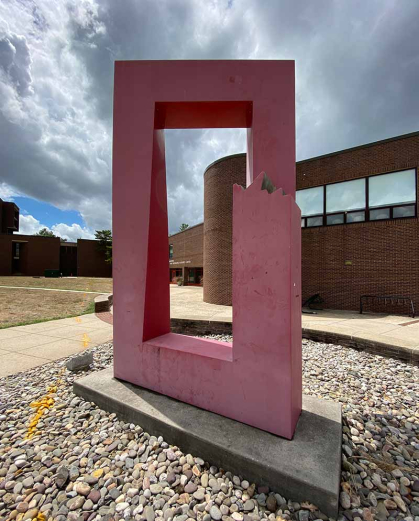
Split and Twisted
Continue east. Located outside the Science and Engineering Resource Center (118 Frelinghuysen Road), this 1980 work by sculptor and furniture maker Paul Sisko is an outline of a red, large steel rectangle that has been split on one side and twisted outwards. Rutgers-New Brunswick’s visits and tours web page notes that this work is commonly seen in Sisko’s “Fractured” series, in which simple geometric shapes are manipulated to create unique visual effects.
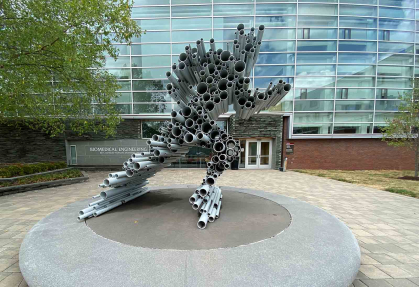
Signal
Now veer northeast and head to the front of the Biomedical Engineering Building, where steel pipes of various sizes and lengths are stacked to suggest a human form in motion. The title of artist Ralph Helmick’s 2009 sculpture refers to an engineering term, namely signal-to-noise ratio. “The core sculptural image is a running figure inspired by Eadweard Muybridge’s 19th century motion studies,” according to the Helmick Sculpture website, adding that “this form reveals itself dynamically depending on the viewer’s location. Stasis and motion; realism and abstraction.”
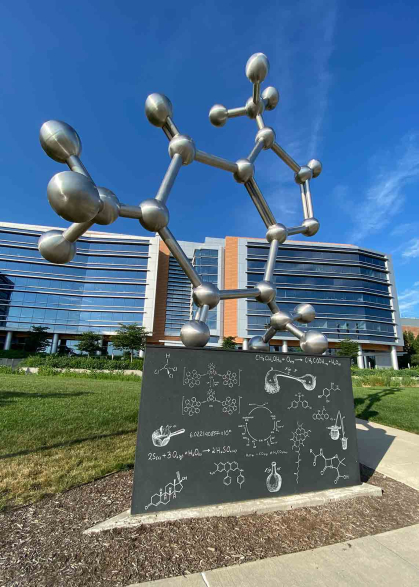
The PhD Molecule
Venture northwest toward Bevier Road to find undeniable proof that scientists do indeed have a sense of humor. This 27-foot structure by sculptor Larry Kirkland, located in front of the Chemistry and Chemical Biology Building, features a large stainless-steel model of a caffeine molecule balanced on a black granite base marked with engravings of chemistry equations and elements. (Watch a short video clip of the 2017 installation.) As the visits and tours web page notes, the piece “is an homage to the late-night brainstorming, meticulous experimentation, and endless cups of coffee that fuel groundbreaking research.”
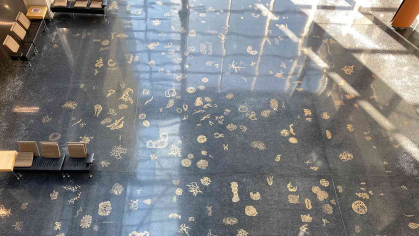
Life Forms
This one is indoors, actually. Head west and peek inside the Life Sciences Building (145 Bevier Road), where bronze figures of microorganisms are embedded in gray terrazzo on the main floor. This 2005 work by Michele Oka Doner, was commissioned under the New Jersey Public Buildings Arts Inclusion Act of 1978.
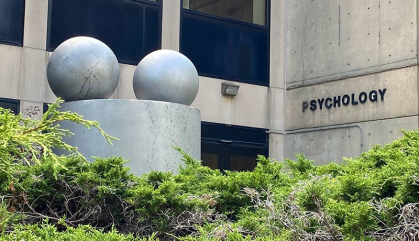
Untitled works
Make your way southwest to the Psychology Building (152 Frelinghuysen Road), home to a pair of untitled stainless-steel sculptures by Patrick Strzelec, professor emeritus in the Department of Art & Design at the Mason Gross School of the Arts, that were installed under the New Jersey Public Buildings Arts Inclusion Act of 1978. Near the entrance on the north side of the building, there are two large spheres resting on a cylindrical base that tapers to a pencil point.
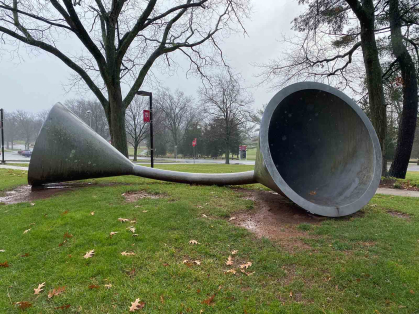
The work on the southern side of the building, near the intersection of Allison and Frelinghuysen roads, is an interactive piece involving two giant funnels connected to a curved pipe. “The sculpture invites passersby to converse with each other by speaking into the two opposing funnel ends,” according to the visits and tours web page. “This activity produces an auditory effect that creates a sensory association with the Psychology Building.”
“They both reference the idea from Carl Jung’s theory of personality,” said Strzelec, adding that the sculptures are on opposite sides of the building by design. “The two pieces suggest the extremes ... the funnel piece being extroversion and the double sphere introversion. The double sphere is an intimate form that is contained, reflective and secure. Introverts prefer one-to-one conversation and are less involved with external stimulation. The cylinder is used as a platform to reinforce the idea of a one-to-one conversation, quiet and serious.”
Note: These 1993 works aren’t the only pieces of art Strzelec has created for Rutgers.
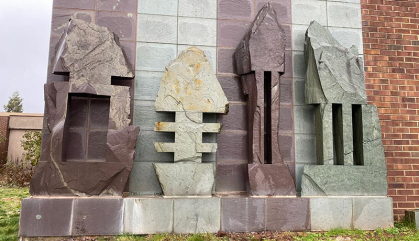
Quaternion I and II
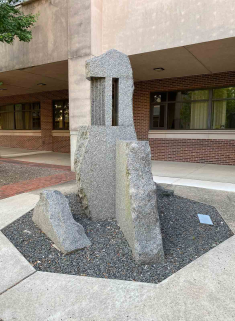
Go northwest to the Environmental and Occupational Health Sciences Institute. This pair of 1992 works by Livio Saganić are located on the northeast corner and the west side of the building. “Quaternion” refers to a group of four members. Quaternion I features four vertical stripes made of panels of gray and blue slate alternate in color with four abstract figures projecting from the exterior wall of the building. Quaternion II is comprised of four pieces carved from granite.
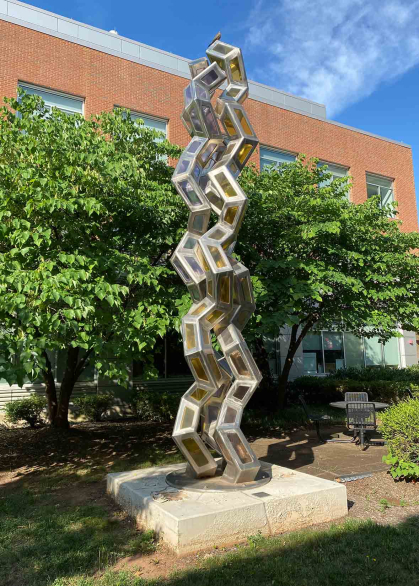
Synergy
Head west to the Proteomics Building (174 Frelinghuysen Road), home of the Institute for Quantitative Biomedicine and the Research Collaboratory for Structural Bioinformatics Protein Data Bank. It's difficult to miss this 20-foot, 3,200-pound work of polished stainless steel and colored glass by scientist-turned-sculptor Julian-Voss Andreae.
The sculpture represents a collagen molecule, the most abundant protein in the human body, and serves as “an allusion to the interdisciplinary nature of biomedical research,” said Stephen K. Burley, director of the RCSB Protein Data Bank and founding director of the Institute for Quantitative Biomedicine.
“This piece is best seen during the day as light passes through it,” notes the visits and tours web page. “During the evening it is illuminated from below, serving as a beacon.”
The 2013 work was erected as a tribute to the center’s founding director, Helen M. Berman, director emerita of the Protein Data Bank.
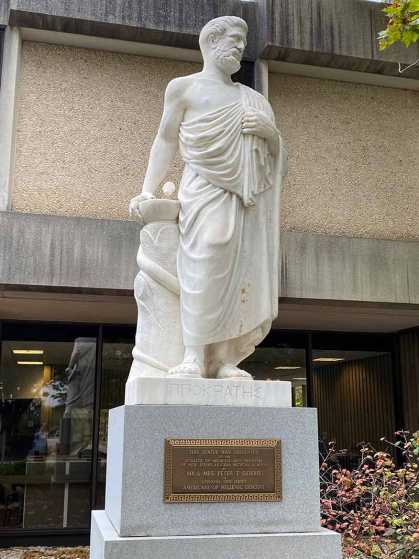
Hippocrates
Take several steps north near the entrance of the Research Tower and the Daniel I. Kessler Teaching Laboratories of Robert Wood Johnson Medical School and you’ll come across this 1973 statue by Costos N. Georgakas depicting the Greek physician and philosopher often referred to as the father of modern medicine. The Hippocratic Oath is inscribed on a plaque on the base.
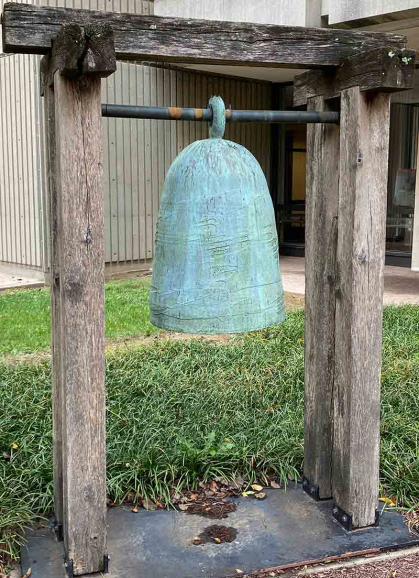
Barcelona
Turn northwest and look for a big bronze bell. This 2002 piece by Toshiko Takaezu, which is located near the entrance of Robert Wood Johnson Medical School stands on a wooden framework (modeled after a traditional Japanese temple gateway). “This piece got its name from when the artist was traveling and heard the sounds of a church bell from her hotel,” notes the visits and tours web page.
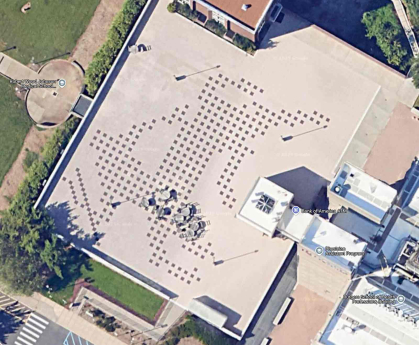
Chiron
Head farther northwest to find this clever but easy-to-miss 1983 work by John L. Goodyear, a former professor of art at Rutgers. Outside the Research Tower there are dark square pavers along with light ones. When viewed from above, the squares form an image of Chiron, a centaur from Greek mythology famed for his wisdom and knowledge of medicine. A teacher and healer who instructed Greek heroes, including Achilles, Chiron was a skilled archer, too. Maybe he created his own patient clientele?
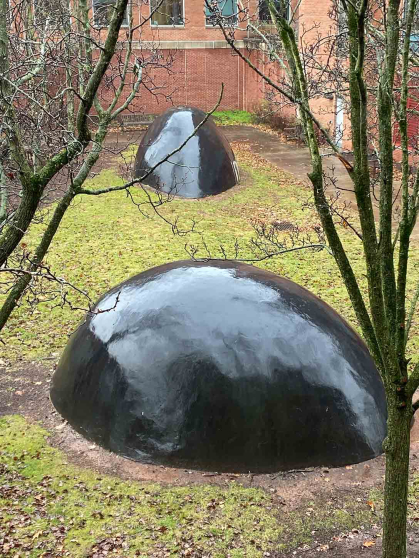
Neither Whales nor Turtles
Go southwest from Chiron to the Center for Advanced Biotechnology and Medicine (679 Hoes Lane West) and look in the courtyard. This 1990 work by Minimalism-influenced artist Jene Highstein features two rounded mounds of painted ferroconcrete that appear to be rising from the ground. The mounds are “too small to represent whales and too big to depict turtles,” according to the visits and tours web page.
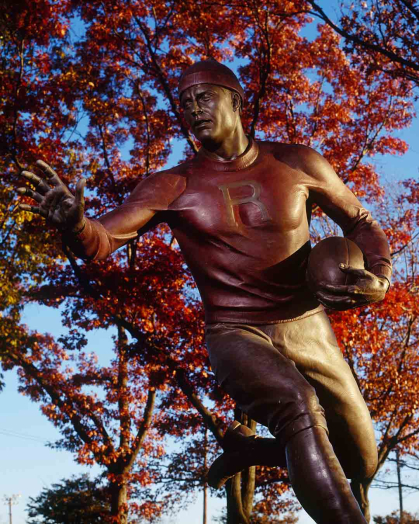
Art Walk Extra Credit
Up for a good 15-minute walk (nearly a mile) from the Busch Student Center? Head to the southern end of the campus to SHI Stadium. Outside the complex off the intersection of Sutphen Road and Scarlet Knight Way stands The First Football Game monument, a 1997 bronze sculpture by Thomas Jay Warren installed as a gift from the Class of 1949. (Rutgers is, after all, the birthplace of college football.)


